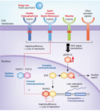General Flashcards
(517 cards)
If a parent has balanced translocation, which type of segregation leads to phenotypically normal offspring? Chromosomally?
Alternate -> phenotypically normal, 50% chromosomally normal

G6PD heterozygote advantage
malaria resistance
Common severe HFE variant, second variant
Cis282Tyr
His63Asp (homozygote unaffected)
What does HFE do?
Regulate hepcidin signalling - iron response hormone that tells body to stop absorbing
When do you treat hemochromatosis
Ferretin > 300 for men or 200 for women
- Goal <50
Why does Factor IV leyden resolve with puberty?
mutation is on promoter which activates with hormone changes after puberty
What gender is hirschsprung more common in?
Males
Uplifted ear lobes, hirschsprung
Mowat Wilson
ZEB2
HTT repeat expansion location and cutoffs
exon 1
Normal 10-25
At risk 26-35
Low penetrance 36-39
Classic 40-59
Juvenile 60
What type of proteins do the most common HCM mutations affect?
Sarcomere or Z disk
What does having DR3 and DR4 alleles place someone at increase risk for? Why?
Insulin dependent diabetes
They are linked with DQB1*0201 and DQB1*0302 alleles (antiben binding clefts in pancreatic island cells)
DR2, which is linked with DQB1*602 is protective
Which 2 genes account for 80% of long QT
KCNQ1 and KCNH2
What do you need to offer relatives of patients with Jervell and Lange-Nielsen syndrome?
EKG. Jevell and Lange Nielsen is AR, but allelic with Romano Ward syndrome (AD long QT)
KCNQ1 and KCNH2
MSH2, MLH1, MSH6, PMS2
Mismatch repair genes -> Lynch Syndrome (HNPCC)
GI cancer (Colon, stomach, intestine, pancreas)
Endometrial/ovarian Ca
Renal Cancer
NO breast/lung ca
MSH6 and PMS2 low penetrance
Lynch syndrome surveillance
Age 20: Colonoscopy (or 5 years before earlierst family hx)
Age 30: Endometrial biopsy every 1-2 yrs, Urine cytology
Age 40: Gastric - EGD every 3-5 yrs
Age 50: MRCP for Pancreatic CA annually
What % of marfan mutations are de novo
~25-33%
What is the skeletal features of marfan
Tall with long arms/long legs: Arm span to height > 1.05, Upper to lower segment
arachnodactyly
Pectus
Scoliosis
joint laxity
narrow palate
Management of Marfan
Annual TTE (root, mitral valve), eye exam
Follow ortho
B-blocker
? Ace/Arb
How is increased nuchal thickness defined?
3mm in 1st trimestery, 6mm in 2nd trimester
What is the most common FAOD?
MCAD
ACADM gene
17p.13 deletion
Brain dysgenesis
Miller-Dieker
Key gene: LIS1
Platelet activating factor acetylhydrolase 1 (PAFAH1)
- Lisencephaly (LIS1) + dysmorphic features (unknown genes)
Recurrence risk for miller dieker
17p13.3 deletion
80% de novo (usual germline mosiacism risk)
20% translocation: 25% abnormal (either del or dup), 25% miscarriage
Mt8344G>A tRNAlys
MERRF
Myoclonic epilepsy with RR fibers
Complex I and IV reduced - mostly synthesized within mitochondria
- Heteroplasmy
- Can also cause multisystemic diasese
- Mutant mitochondrial accumulate with age (mtDNA has 10x mutaton rate vs chromosomal DNA)
Tx: CoQ10 and Carnitine
What % of NF patients have a de novo mutation?
50% - NF has a very high mutation rate













































































